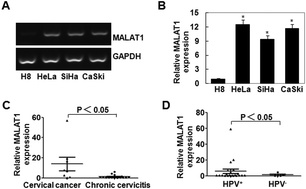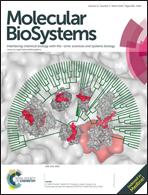Down-regulation of MALAT1 inhibits cervical cancer cell invasion and metastasis by inhibition of epithelial–mesenchymal transition†
Abstract
The metastasis-associated lung adenocarcinoma transcript 1(MALAT1), a member of the long non-coding RNA (lncRNA) family, has been reported to be highly enriched in many kinds of cancers and to be a metastasis marker and a prognostic factor. In this study, we found that MALAT1 expression levels were significantly increased in cervical cancer (CC) cells and tissues. The down-regulation of MALAT1 by shRNA in CC cells inhibited the invasion and metastasis in vitro and in vivo. Microarray analysis showed that the knockdown of MALAT1 up-regulated the epithelial markers E-cadherin and ZO-1, and down-regulated the mesenchymal markers β-catenin and Vimentin. This regulation was further confirmed by subsequent observation from RT-PCR, western blot, and immunofluorescence results. Meanwhile, the transcription factor snail, which functions to modulate epithelial–mesenchymal transition (EMT), was also down-regulated at both transcript and protein levels by MALAT1 down-regulation. In addition, we found that MALAT1 expression levels were positively related to HPV infection in cervical epithelial tissues by microarray analysis. Taken together, these results suggest that MALAT1 functions to promote cervical cancer invasion and metastasis via induction of EMT, and it may be a target for the prevention and therapy of cervical cancers.


 Please wait while we load your content...
Please wait while we load your content...